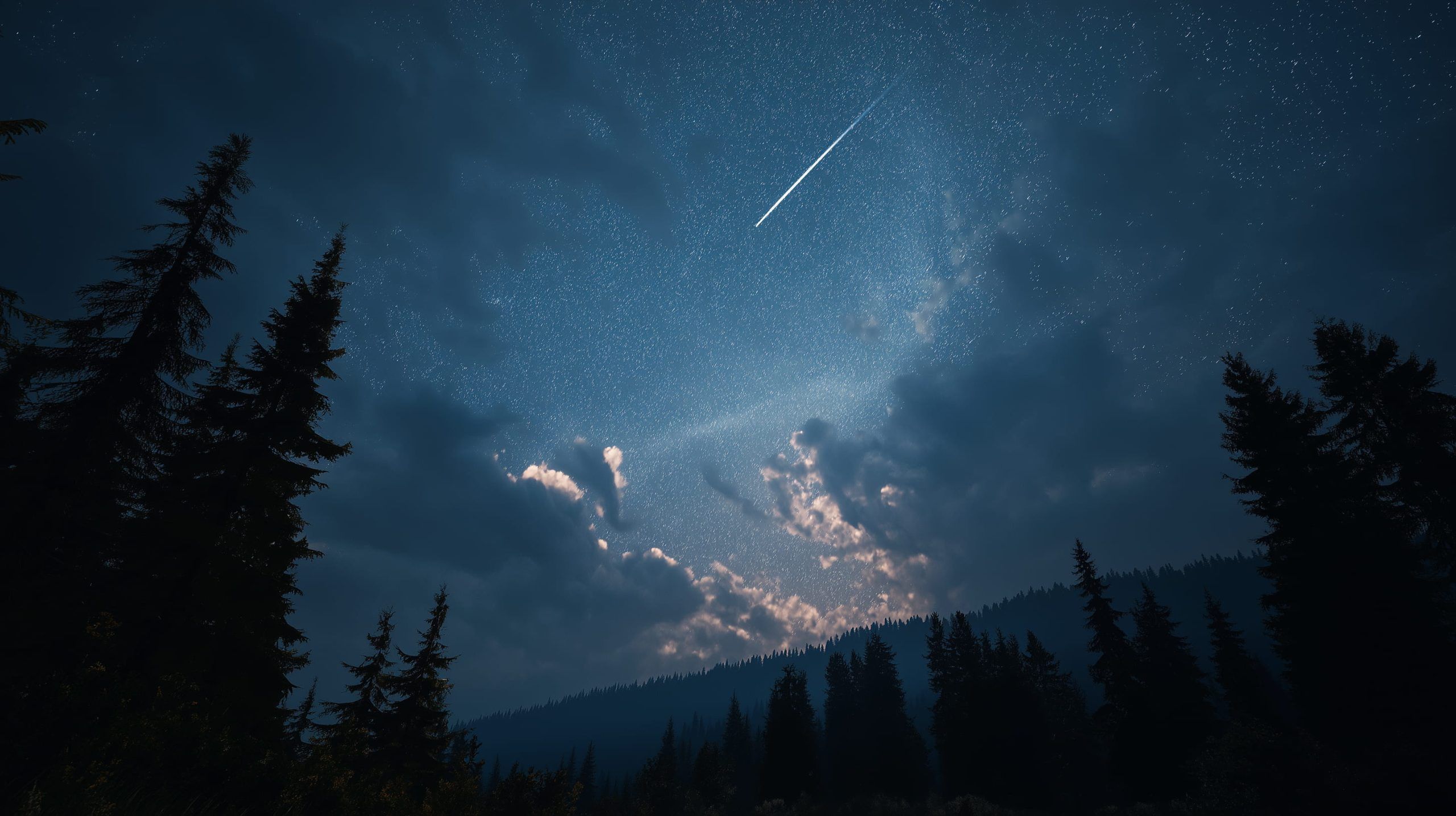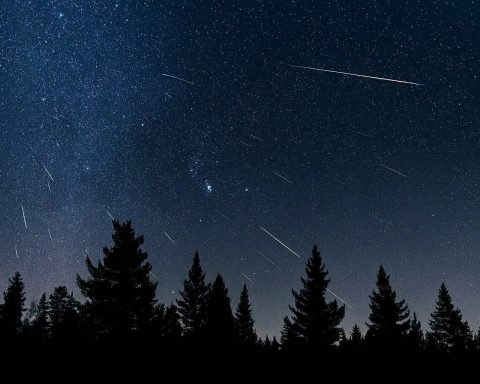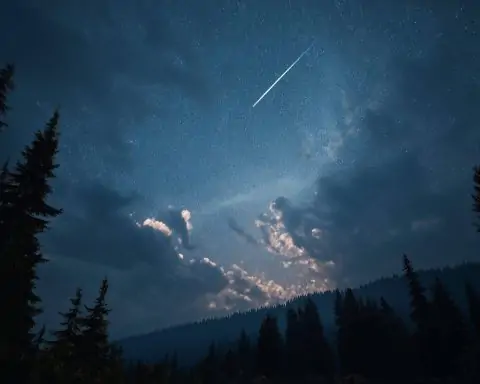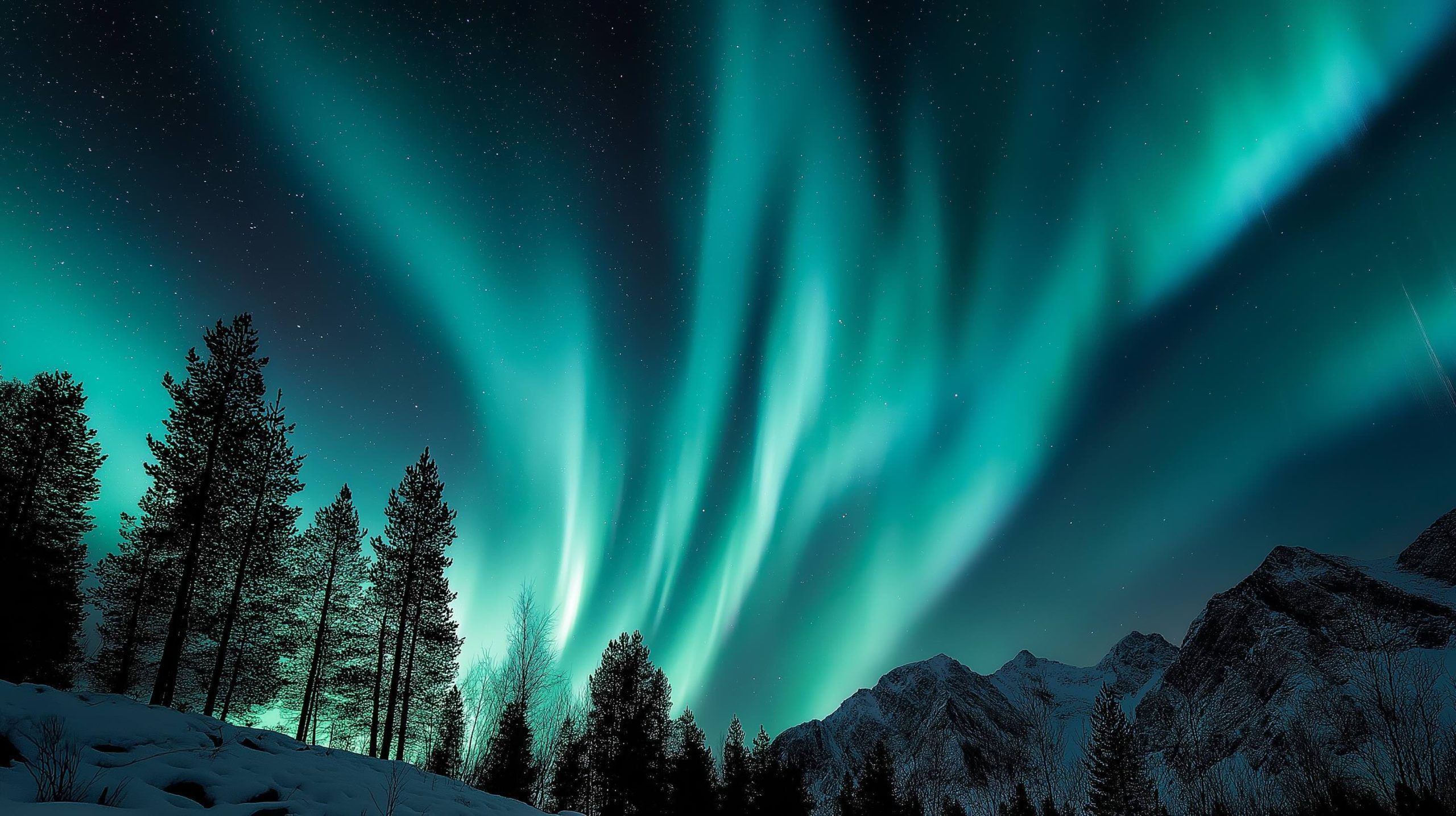- Meteor action under dark skies: A minor Aurigids meteor shower peaks this weekend (Aug 30–Sep 1) with only around 5–10 meteors per hour expected at best [1]. Exceptionally dark, moonless late-night skies will help reveal any shooting stars. The famous Perseids earlier this month were washed out by bright moonlight – “instead, you’re probably going to see 10 to 20 per hour or fewer” at peak, noted NASA meteor expert Bill Cooke [2] – and by now only the odd stray Perseid meteor remains.
- Five planets on display: All five naked-eye planets can be spotted in one night this weekend [3]. Mars glimmers very low at dusk; Saturn (nearly at opposition) rises by ~8:30 p.m. and shines all night [4]; brilliant Jupiter and Venus beam in the pre-dawn hours (Venus at an eye-popping –4.5 magnitude) [5]; and elusive Mercury peeks above the horizon just before sunrise [6]. A bright half Moon will adorn the evening sky in Scorpius, sitting near red supergiant Antares on Aug 30–31 [7]. (In fact, for skywatchers in New Zealand and Antarctica, the Moon will briefly occult Antares – pass right over it – on August 31 [8].)
- Aurora watch & space weather: Earlier this week, a high-speed solar wind stream hit Earth’s magnetic field, sparking minor geomagnetic storm conditions (Kp 4–5) and faint auroras at high latitudes [9] [10]. NOAA’s Space Weather Prediction Center even issued a G1 (Minor) storm watch for Aug 27 [11]. By the Aug 30–31 weekend, however, geomagnetic activity is expected to settle back to quiet levels (Kp ~2–3), keeping any auroras confined to polar skywatchers [12]. In short, only far-northern or southern observers might catch a subtle glow on the horizon under clear, dark skies.
- Sun is stirring, but no big storms now: The Sun is growing more active as it heads toward its solar maximum. Between Aug 25–26, solar monitors recorded five moderate M-class flares erupting from new sunspot groups [13]. “Action is picking up on the eastern solar disk,” observed NASA solar physicist Dr. C. Alex Young, noting these regions are “setting the stage for more volatile days ahead” [14]. Fortunately, none of those flares hurled a major CME (coronal mass ejection) toward Earth [15]. So aside from the earlier minor aurora, no significant space weather impacts are expected this weekend. (There are no eclipses on Aug 30–31 either – the next major eclipse will be a total lunar “Blood Moon” on Sept 7–8, 2025 [16].)
- Satellites & ISS sightings: Keep an eye out for some human-made “stars” as well. Thanks to two SpaceX launches a few days ago, newly launched Starlink satellite “trains” may be visible after dusk or before dawn – appearing as a line of bright, evenly spaced lights moving across the sky [17] (often mistaken for a UFO!). Also, the International Space Station (ISS) continues its regular flyovers. In late August many locations have predawn ISS passes, where the station (carrying 7 crew) shines as a fast-moving, non-blinking “star” traversing the sky in ~4 minutes [18] [19]. NASA’s Spot the Station tool can provide exact viewing times for your city. Now is a great chance to wave up to the astronauts and appreciate our dynamic night sky!
Dark Skies and Meteor Showers: Perseids Fade, Aurigids Arrive
Late August 2025 brings wonderfully dark night skies thanks to the Moon’s phase. August 23 was a rare “Black Moon” (a third new moon in a season), so evenings around Aug 27–30 have had little moonlight [20]. By this weekend the Moon is only about 7–8 days old (first quarter phase), setting around midnight and leaving most of the night moonless [21]. These dark conditions are ideal for spotting faint meteors, the Milky Way, and other dim celestial sights without glare [22].
Meteor activity this weekend comes from two sources: the tail end of the Perseid shower and the beginning of the Aurigids. The Perseids – one of the year’s most celebrated meteor showers – peaked on Aug 12–13 under a blinding 84%-full Moon in 2025. Normally, under dark skies the Perseids can deliver 50–75 meteors per hour, but this year’s bright Moon drastically cut that rate. “The average person under dark skies could see 40–50 Perseids per hour” in a good year, “instead, you’re probably going to see 10 to 20 per hour or fewer, and that’s because we have a bright Moon…washing out the fainter meteors,” explained Bill Cooke, lead of NASA’s Meteoroid Environment Office [23]. Indeed, only the very brightest Perseid fireballs managed to shine through the moonlight. By now (late August), the Perseid shower is effectively over – you might catch one or two slow, random Perseid meteors before dawn if you’re lucky, but rates are down to only a few per hour at most [24].
On the other hand, a different meteor shower is just getting underway: the Alpha Aurigids. Active from roughly August 28 to September 5 each year, the Aurigids are an unusual, generally weak shower that peaks around August 31 – September 1 [25]. In 2025 the Aurigid peak is expected to produce at best around 5–10 meteors per hour under ideal dark skies [26]. That’s a pretty sparse showing – casual observers might not notice much difference from the usual random “shooting stars” on any given night. In fact, experts note the Aurigids “are typically very sparse” most years [27].
Why so few meteors? The Aurigids originate from a long-period comet named Kiess (C/1911 Kiess) that swings through the inner solar system only about once every 2,000 years [28]. Unlike prolific showers fed by short-period comets (which lay down broad, dense dust streams), Kiess’s infrequent visits leave behind just a narrow, patchy trail of debris. Earth barely grazes this thin trail each year, so usually only a handful of dust grains hit our atmosphere – hence the meager meteor rates [29].
That said, the Aurigids have a reputation as one of the “rarest” showers for a reason: they occasionally surprise observers with outbursts. The shower was actually discovered in 1935 when an unexpected Aurigid display produced spectacular meteors on August 31 of that year [30]. More recently, on Sept 1, 2007, the Aurigids astonished skywatchers with a brief burst of 100+ meteors per hour, far above normal levels [31]. (NASA even flew an airborne observation campaign to study that 2007 outburst [32].) Other minor upticks – on the order of 30–50 meteors/hour – were noted in 1986, 1994, and 2019 [33]. These rare outbursts happen when Earth plows through a denser filament of Kiess’s dust stream – essentially we hit a jackpot section of debris. Astronomers calculate no significant Aurigid outburst is due again until the 2070s [34], so no enhanced activity is predicted in 2025. Still, it’s always worth watching in case a random fireball (bright meteor) streaks by; even one spectacular meteor can make your night memorable. The Aurigid meteors tend to be fast-moving (impacting at ~66 km/s) and sometimes leave persistent trails [35], so any that do appear could be eye-catching.
How to watch for meteors: Find a dark location away from city lights, get comfy (a reclining lawn chair or blanket is ideal), and simply gaze up at the sky after midnight. Meteor rates usually improve in the wee hours as your location faces into Earth’s direction of travel through space. For Aurigids, the shower’s radiant (in the constellation Auriga, near the bright star Capella) rises after ~11 p.m. local time and climbs higher during the pre-dawn hours [36]. You don’t need to look directly at the radiant – meteors can flash across any part of the sky – just watch wherever your sky is darkest and give your eyes ~20 minutes to adapt to the dark. Plan to observe for at least an hour if possible; meteors often come in spurts with lulls in between. With the Moon setting early, the Milky Way will be on full display as a ghostly band of light across the sky, adding to the experience. Even if meteor counts are low, you’ll enjoy a dazzling star-filled sky under these moonless conditions.
Aurora Alert Fizzles Out: Northern Lights Mostly Quiet
Will the Northern Lights make an appearance on Aug 30–31? Probably only in very high latitudes, if at all – and even there, chances are slim by the 31st. Earlier this week, aurora enthusiasts were on alert due to a minor geomagnetic disturbance brought on by our restless Sun.
Solar activity has been ramping up as the Sun approaches the peak of its 11-year cycle (Solar Cycle 25). In late August, multiple new sunspot regions have been crackling with flares on the Sun’s Earth-facing side. Notably, between Aug 25 and 26, solar monitors recorded five M-class solar flares (moderate-intensity flares) erupting from two emerging sunspot groups labeled AR4197 and AR4199 [37]. “Action is picking up on the eastern solar disk,” observed Dr. C. Alex Young, a NASA solar astrophysicist, noting that these active regions are “setting the stage for more volatile days ahead.” [38] In other words, the Sun has a lot of pent-up magnetic energy right now. One of the flares on Aug 26 was fairly strong (an M4.5) and did cause a brief high-frequency radio blackout on the sunlit side of Earth [39]. However, none of the recent flares launched a major Earth-directed CME (coronal mass ejection) – either the eruptions were confined to the far side of the Sun or the plasma blasts were weak/missed Earth [40]. This was a lucky break, as big Earth-directed CMEs are the usual trigger for strong geomagnetic storms and auroras.
Instead, the more relevant space-weather influence this week came from a large coronal hole on the Sun that rotated into geoeffective position. Coronal holes are regions of the Sun’s atmosphere where the magnetic field opens up, allowing high-speed solar wind to stream out. In this case, a broad coronal hole sent a gusty stream of charged particles toward Earth starting around Aug 26–27 [41]. When such a solar wind stream arrives, it can disturb Earth’s magnetosphere, causing “unsettled” to “active” geomagnetic conditions and sometimes even a minor G1-class geomagnetic storm if the magnetic field orientation is favorable.
Official aurora alerts: Space-weather forecasters were indeed eyeing this situation. The U.S. NOAA Space Weather Prediction Center (SWPC) issued a minor geomagnetic storm watch for August 27, expecting that the coronal hole’s stream might push Earth’s magnetic activity to G1 storm levels (Kp index of 5) for brief periods [42]. NOAA predicted “unsettled to active” geomagnetic conditions through Aug 27, with a slight chance of hitting the G1 (Minor storm) threshold [43]. In practical terms, that meant auroras were possible in upper latitudes on the night of the 27th – perhaps dipping down into northern parts of Europe, Canada, and the northernmost U.S. if a Kp 5 materialized.
And in fact, during the nights of Aug 27–28 the Earth’s magnetic field did become perturbed (Kp 4 to 5) at times – just about at minor storm levels [44]. Some modest auroral displays were reported: skywatchers in places like Iceland, northern Scotland, Norway, Canada, and Alaska caught faint green glows and quiet auroral arcs in the night sky (consistent with a Kp 4–5 event) [45]. The auroras were not particularly strong or far-reaching, but those in very high latitudes saw a nice light show.
By Aug 28, however, the solar wind effects were waning. NOAA forecast a return to quieter geomagnetic conditions with only isolated unsettled periods lingering into Aug 28–29 [46]. The latest outlook heading into the weekend suggests no significant geomagnetic storming for the nights of Aug 29–30 [47]. The planetary K-index was expected to hover in the low range (Kp 2 to 3, meaning quiet to slightly unsettled) as the solar wind stream dissipates [48]. In summary, the best window for auroras was around the 27th; by the time of Aug 30–31, Earth’s magnetic field is settling back to normal.
Aurora viewing prospects: If you live in a high-latitude region, it’s still worth glancing northward (or southward in the Southern Hemisphere) after local midnight on the off-chance of any residual auroral activity. Under dark skies, even a minor uptick can produce a faint greenish glow low on the horizon. With the Moon’s light out of the way late at night, any subtle aurora will be easier to spot. Observers in far-northern locales – roughly above 55° N latitude (e.g. northern Canada, Alaska, northern Scandinavia, Scotland) – or far-southern locales (Tasmania, New Zealand’s South Island) should watch the sky in case a diffuse auroral band or small flickers of pink/green appear. Keep expectations low, though. As NOAA notes, we’re likely below storm level now, so the aurora will probably stick to its usual polar zones [49] [50].
For context, a G1 (Kp 5) geomagnetic storm is fairly mild – it can drive auroras a bit farther from the poles (sometimes to around 50° magnetic latitude, which includes the northern tier of the U.S. or central Europe) [51]. But anything less, like Kp 4, usually keeps auroras confined to the Arctic/Antarctic circle regions. One space-weather expert notes that even a minor G1 storm can occasionally be seen “as far south as northern-tier U.S. states or mid-latitude Europe” under ideal conditions [52], but that would be the exception rather than the rule. Given the quiet forecast for Aug 29–31, realistically only dedicated aurora chasers in the far north or south might catch a subtle auroral arc or pulsing glow.
If you want to monitor aurora potential in real time, there are great resources available. NOAA’s SWPC offers an Aurora 30-minute forecast map (updated in real-time) on their website [53], and there are smartphone apps and social media alerts (on Twitter/X, etc.) that notify you when geomagnetic indices spike. But if nothing else, simply enjoy the sky itself – this weekend’s dark, Moon-free sky means you’ll see plenty of stars. Sometimes the Milky Way and even atmospheric airglow can paint the sky in ghostly light, offering their own subtle show even when auroras stay absent.
Parade of Planets: Five Bright Planets from Dusk till Dawn
Stargazers are in for a treat: all five of the classic naked-eye planets – Mercury, Venus, Mars, Jupiter, and Saturn – make an appearance in the sky on the nights of August 30–31. You won’t see them all at once (they span the evening through dawn), but with a bit of timing you can spot each of the five worlds in a single night [54].
Here’s how to catch the planetary parade:
- Mars – Subtle at Sunset: Mars is the first up, but also the most challenging to see. The Red Planet is currently distant and fairly dim (around magnitude +1.7, similar to an average Big Dipper star [55]). It’s also very low on the horizon at dusk. Look just after sunset toward the west-northwest. Mars will appear as a tiny faint amber “star” very low in twilight – only about 5–10 degrees above the horizon during the first 30–60 minutes after sunset (roughly a fist’s width at arm’s length) [56]. By an hour or so after the Sun sets, Mars itself sets and disappears. Binoculars may help pick it out against the bright twilight sky. (Mars was near the crescent Moon a few days earlier on Aug 25–26, but by this weekend the Moon has moved on, so Mars stands alone.) If you manage to glimpse Mars before it sinks – congratulations, you’ve bagged planet #1!
- Saturn – All Night Long: As Mars exits, Saturn enters. The ringed planet is currently rising in the east around nightfall and is nearly at its brightest for the year. Saturn’s opposition (when it lies opposite the Sun in our sky, hence closest to Earth and brightest) will occur in a few weeks on Sept 21, 2025 [57]. That means in late August, Saturn is already shining big and bright, and it stays visible all night. By August’s end Saturn rises by roughly 8:30–9:00 p.m. local time (even earlier for those at higher northern latitudes) [58]. By 10–11 p.m. it climbs reasonably high above the horizon for good viewing, and it reaches its highest point in the southern sky around 2–3 a.m. before eventually setting near sunrise [59]. To the naked eye, Saturn appears as a steady, golden-yellow “star” of about magnitude +0.5 – not as brilliant as Jupiter or Venus, but among the brighter stars in the late-night sky. It currently resides in the constellation Pisces, which has no bright stars, so Saturn stands out clearly in that area [60]. If you have a telescope, now is a fantastic time to observe Saturn’s famous rings and moons. Even a modest backyard telescope will reveal the rings (currently they’re tilted nearly edge-on from our viewpoint, so they look thinner than usual this year) and perhaps Saturn’s largest moon Titan. Good binoculars might even hint at Saturn’s elongated shape (due to the rings). But even without any optics, just appreciating Saturn with the unaided eye can be thrilling – that steady golden point of light is actually a gas giant 800 million miles away, with a majestic ring system encircling it. If you’re out with friends or family, be sure to point out Saturn to those who have never seen it. Many first-time viewers are excited to realize that this dot of light is the ringed planet we’ve all seen in photos.
- Jupiter – Late Night/Dawn Beacon: Next up is Jupiter, the largest planet, which rises much later in the night. In late August 2025, Jupiter is a pre-dawn object – it doesn’t come up until the wee hours of the morning. Around Aug 30, Jupiter rises in the east-northeast roughly between 2:00 and 3:00 a.m. local time (earlier if you’re farther north) [61]. By dawn, Jupiter is fairly high in the eastern sky. There’s no mistaking it – Jupiter is extremely bright (currently about magnitude –2.5) and easily outshines every star in the morning sky [62]. It appears as a bold, steady white dot. If it’s very low to the horizon when you first spot it, Jupiter might twinkle a bit (due to looking through more atmosphere), but higher up it shines with a steady light. This giant planet is hanging out in the constellation Aries at the moment, not far from the Pleiades star cluster and the “horns” of Taurus – though the encroaching dawn light will make those fainter neighbors hard to see. Fun fact: Jupiter and Venus actually had a close conjunction earlier this month on Aug 11–12, when they passed within just about 1° of each other (appearing side by side before sunrise) [63] [64]. They’ve separated a bit since then, but here at the end of August both planets are still sharing the pre-dawn stage. In fact, if you’re up before sunrise, you might see Jupiter rising in the east while Saturn is sinking low in the west – a lovely tableau of two bright planets on opposite horizons around 5:00 a.m.
- Venus – The Dazzling “Morning Star”: The undisputed brightest planet right now is Venus. After spending a couple of months lost in the Sun’s glare (it passed between Earth and the Sun in early August during inferior conjunction), Venus has re-emerged as a brilliant “Morning Star.” In late August, Venus rises roughly 3.5–4 hours before the Sun. For example, on August 30, Venus pops above the eastern horizon around ~4:00 a.m. (give or take, depending on your latitude) and climbs to about 20–30° high by the time dawn light starts glowing [65]. At magnitude ~–4.5, Venus is absolutely unmissable – it’s the first “star” you’ll see fading away as the sky begins to brighten at dawn, and if you’re up early in the dark, it’s often mistaken for an airplane or even something more outlandish because of how intensely it shines. If you’re awake at 4–5 a.m., look toward the east: Venus will be that dazzling white beacon lighting up the sky [66]. This is an excellent time to view Venus through a telescope as well, since it currently shows a large crescent phase (like a tiny crescent moon) – a result of its angle relative to Earth and the Sun. Just be careful to stop observing before the Sun comes up (never point a telescope near the Sun once it’s rising, as accidental sun-glare can damage your eyes or equipment). With the unaided eye, of course, there’s no risk – you can simply enjoy Venus’s piercing glow. Around these dates, Venus is moving from the constellation Cancer into Leo. It had a lovely close pairing with the crescent Moon back on Aug 19–20 which some early risers may have caught [67], but for this weekend Venus stands alone as the morning spotlight.
- Mercury – A Difficult Dawn Challenge: Last but not least, Mercury is technically visible just before sunrise – but it’s a tough catch even for seasoned observers. Mercury is the innermost planet, never straying far from the Sun from our point of view, so it only emerges during brief windows at dawn or dusk a few times each year. In late August 2025, Mercury is having a morning apparition (visible in the east at dawn). It will reach its greatest western elongation (furthest apparent separation from the Sun in the morning sky) in the first week of September. By Aug 30–31, Mercury is just beginning to peek out of the sunrise glow. Look for it very low on the east-northeastern horizon about 30–45 minutes before sunrise. For many mid-latitude locations, that means roughly around 5:30–6:00 a.m. local time (since sunrise this time of year might be around 6:15–6:45) [68] [69]. Mercury will only be perhaps 5–8 degrees above the true horizon at that time – about one outstretched fist-width at arm’s length [70]. It shines at about magnitude +0.8 right now, which is relatively faint, and the brightening dawn sky makes it even harder to spot [71]. To improve your odds, find a location with a clear view of the horizon (like an ocean shore or a flat plain) and use binoculars just before sunrise to scan for a tiny star-like point above where the Sun will rise. Mercury will appear as a small, twinkling dot of light. If it’s sparkling, it might be a star (or atmospheric effect), but if it’s a steady light and in the right spot, it’s likely Mercury. Don’t be discouraged if you miss it – catching Mercury is notoriously tricky. It will become a bit easier in the first few days of September as it climbs slightly higher each morning and brightens a bit before heading back toward the Sun by mid-September. If you do manage to spot Mercury, give yourself a pat on the back for completing the 5-planet lineup!
To summarize the planet schedule: Right after nightfall, Mars briefly glints low in the west. Through late evening and midnight, Saturn takes over, rising and dominating the southern sky. In the early pre-dawn hours, Jupiter joins the scene in the east, followed by blinding Venus high in the twilight. And if you time it right, Mercury can be the final cherry on top just before the Sun comes up. It’s like a relay across the night by our planetary neighbors. With the Moon only a modest crescent this weekend, moonlight won’t wash out the planets – in fact, the pretty crescent Moon itself can be considered an honorary member of the show. In its monthly skywatch guide, NASA notes that all month long the planets have been arranged for exactly this kind of viewing: “Mars can be observed low in the west during the hour after sunset… Jupiter and Venus shine brightly in the east each morning before sunrise… Saturn [is] observable late night to dawn,” according to NASA’s August skywatching tips [72]. So take advantage of these late-summer nights to spot all the bright planets!
And don’t forget to also enjoy the Milky Way: with the Moon largely out of the way, the misty river of the Milky Way is plainly visible after dark in August. In early evening it arches across the eastern sky; by midnight it soars high overhead; and by pre-dawn it leans toward the west. Look for that milky band of light flowing through constellations like Cygnus (the Northern Cross), Cassiopeia, and down toward Sagittarius in the south. From a dark site, you might discern the Milky Way’s dark dust lanes and brighter star-cloud patches. It’s a beautiful reminder that our Sun is just one star among billions in our galaxy – a perfect backdrop while you’re hopping from planet to planet with your eyes.
Moon Meets Antares: Lunar Close Encounter in Scorpius
As an added treat, the Moon will be rendezvousing with one of the sky’s brightest stars this weekend. On the evenings of Aug 30 and 31, the waxing half moon (first quarter phase on the 30th) shines in the constellation Scorpius, positioned near the red supergiant star Antares. Antares – often called the “Heart of the Scorpion” – is a ruddy, 1st-magnitude star, and seeing it near the bright Moon is a striking sight.
On Saturday, Aug 30, look toward the southwest as night falls. The first-quarter Moon will be roughly 50% illuminated and hanging in the head of Scorpius. Antares will be positioned about 5° to the Moon’s upper left (around a few finger-widths apart at arm’s length) for observers in North America that evening [73]. The second-brightest star in Scorpius, Sigma Scorpii (also known as Al Niyat), will be a similar distance to the Moon’s upper right [74]. The Moon’s glare will make Antares’ color a bit harder to see, but if you use binoculars (or when the Moon gets lower in the sky), you may notice Antares has an orange-red hue – it’s a massive red supergiant star, hundreds of times larger than our Sun.
By Sunday, Aug 31, the Moon will have moved eastward in the sky relative to Antares. Now Antares and the fainter Sigma (Delta) Scorpii will appear roughly to the right of the Moon at nightfall, forming a line with the Moon [75]. The Moon will be a thicker waxing gibbous by this point (~60% lit). Although the Moon is bright, Antares should still be visible to its side – try comparing how much more the star twinkles than the steady gleam of the lunar disk.
Interestingly, on Aug 31 the Moon–Antares pairing turns into an actual occultation (where the Moon covers the star) for certain parts of the world. Because the Moon is much closer to us than the stars, its exact alignment in the sky depends on your location. In some far-southern regions – specifically Antarctica, southwestern New Zealand, and nearby ocean areas – the Moon’s path will line up precisely to cover Antares for a short time on Aug 31 [76]. Observers in those locations (likely few in number!) would see Antares disappear behind the Moon’s bright limb and reappear later. Outside of that narrow zone, the rest of the world will not see the star actually blink out, but the Moon and Antares will still be very close together in the sky – a lovely conjunction visible to the naked eye [77].
If you have a telescope, watching the Moon glide by Antares can be fascinating. Even where no occultation occurs, you can see the glaring Moon and pinpoint Antares in the same field (just be mindful of the Moon’s brightness). If an occultation is visible from your area, it’s a special event: you can witness the star winking out instantly as the Moon’s edge covers it, then popping back into view along the dark limb. But for most readers, simply observing the close approach is rewarding – it’s a chance to easily locate Antares (which is normally one of the brightest stars of summer) and observe color contrast between the Moon’s white-gray and the star’s reddish tint.
This Moon–Antares encounter serves as a reminder that no eclipses or major lunar events are happening on these dates – the Moon is just going through its regular orbit, but aligning near a notable star. (The next big lunar event will be a total lunar eclipse coming up on September 7–8, 2025, which will turn the Moon blood-red for observers across Asia, Australia and more [78] – mark your calendars for that!). For now, enjoy the more subtle beauty of the Moon dancing through Scorpius on these late-summer nights.
Satellites and Space Station: Bonus Sights in the Sky
Not all the night’s spectacles are natural – human-made satellites are part of the sky show too. This weekend, keep watch for a couple of striking artificial sights: newly launched satellite “trains” and the trusty International Space Station, which may grace your skies in the pre-dawn hours.
Starlink “Trains” of Lights
If you happen to see a line of strange, evenly spaced lights crawling across the sky, don’t panic – you’ve likely spotted a batch of SpaceX Starlink satellites. In the past week (on Aug 27 and 28), SpaceX launched two Falcon 9 rockets carrying dozens of Starlink internet satellites. When these flat-panel satellites are first released in orbit, they stick together in a tight formation and reflect sunlight strongly. The result is a visible “train” of bright lights in the night sky, which has prompted many surprised onlookers to report “UFO” sightings. As described by a Space.com astronomy columnist, “on clear nights, you may spot these satellites as they streak across the sky, resembling a string of bright, evenly spaced lights.” [79] It’s quite a spectacle – a chain of artificial stars moving in unison.
If you’re in Florida or the southeastern U.S., you might have even caught the launches themselves – the Aug 27 pre-dawn launch created a glowing jellyfish-like cloud in the sky, and the Aug 28 midnight launch produced a brief flare of light as well [80]. Now that the satellites are in orbit, when and where can you see the “train”? Typically, the best time to spot a new Starlink train is one to three days after launch, once the satellites have spread out a little but are still in a relatively tight group. That means Aug 28–30 were the prime evenings/mornings to catch these particular sets [81], but even as we hit Aug 30–31 they may still be visible, just more diffuse.
The visibility depends on your location and timing – you need the satellites to be above the horizon and illuminated by the Sun (which generally means looking during the hour or two after sunset or before sunrise, when your sky is dark but the satellites are high enough to catch sunlight). The newly launched groups are in orbits that might make evening sightings possible for some latitudes and pre-dawn sightings for others [82]. To improve your odds, you can use online tools like Heavens-Above or FindStarlink. These services let you input your location and get a list of upcoming pass times for Starlink satellites (often highlighting if a “chain” is expected). Look for a prediction in the first couple hours after dusk or before dawn. When a train pass occurs, you’ll see a series of magnitudes ~2–4 “stars” moving together across the sky. Initially, they may appear bunched in a line a few degrees apart, almost like the dots of a moving ellipsis. As days go by, they drift further apart and grow dimmer individually, becoming less obvious as a coherent train. (Also, note that SpaceX has been working to reduce the brightness of Starlinks by adding sunshades and darker coatings, so newer satellites are not quite as bright as the early ones launched in 2019 [83]. Still, if you’ve never seen a Starlink train, it can be a startling sight!)
While spotting a satellite train is fun, it’s also a teachable moment: astronomers have raised concerns about these mega-constellations cluttering the night sky. Thousands of satellites (Starlink alone has over 8,000 in orbit as of August 2025, with ~8,000 currently functioning) now streak through the skies [84]. They can photobomb telescope images and contribute to night sky light pollution [85]. So enjoy the view, but spare a thought for how we’re gradually filling Earth’s orbital space. The appearance of these satellite chains is a very visible reminder of the new space age we live in.
The International Space Station
Meanwhile, the brightest artificial satellite of all – the International Space Station (ISS) – continues to make regular passes over communities worldwide. The ISS is easily the brightest man-made object in the sky, often rivaling Venus in brilliance at around magnitude –3 to –4 when overhead [86]. It looks like a very bright star moving steadily across the sky, taking about 4–6 minutes to go from one horizon to the other. Unlike an airplane, it has no flashing lights and no colored lights; it also moves much faster than a typical plane, crossing the sky smoothly and then usually fading out abruptly as it slips into Earth’s shadow.
Can you see the ISS on Aug 30–31? Almost certainly yes somewhere, since the station’s orbit is inclined ~51.6° to the equator – meaning it passes over most inhabited areas of Earth at some point. In fact, as NASA notes, the ISS’s trajectory covers “more than 90% of Earth’s population.” [87] However, the ISS isn’t necessarily visible every night at a given location; it depends on the timing. You need it to pass overhead while your sky is dark (early morning or evening) and the station is catching sunlight (so it glows against the darker sky).
In late August, many mid-northern latitude locations (like most of Europe, the continental US, etc.) are transitioning from evening ISS passes to predawn passes. Earlier in the month, the ISS was often visible in the evenings, but by Aug 29–31 the morning twilight hours tend to be when the ISS appears for those regions [88]. Conversely, in some far-northern areas or in parts of the Southern Hemisphere, there might still be some evening sightings. The simplest way to know is to use NASA’s Spot the Station website or a smartphone app (like ISS Tracker) – you input your city and it will give you a list of upcoming sighting opportunities.
For example, let’s say you’re in Warsaw, Poland (~52°N latitude). Around Aug 27–30, the Spot the Station tool might show ISS passes occurring around 4:30–5:00 a.m. local time, moving low across the southern sky [89]. Indeed, the TS2 Space skywatch blog reported bright ISS flyovers for Warsaw at ~4:40 am on Aug 27–28, traveling low from the west/southwest toward the east [90]. By Aug 29–30 those times shift slightly (a few minutes earlier each day), but the pattern is similar – early morning passes, appearing in the west-southwest and sliding eastward before fading out. If you’re instead in, say, the southern U.S., your viewing times could differ (likely also pre-dawn this week, but exact hours depend on orbit timing). Sometimes there are multiple passes in one night, ~90 minutes apart, but often only one or two are easily visible at a given locale.
Whenever an ISS pass is due, go out a few minutes early. Look in the general direction and altitude indicated by your alert (for instance, “appears 10° above WSW horizon, disappears 30° above NE horizon”). Be patient – at the given start time, a bright light will suddenly become visible, rising or moving along that path. It will not have blinking aircraft lights; rather, it will shine with a steady white glow. If it’s a high pass, it will reach a spectacular brilliance when it’s overhead and reflecting maximum sunlight. If it’s a lower pass (closer to horizon), it might not get as bright but can still be obvious if skies are clear. Watching the ISS cruise across the stars is quite enjoyable – and a great way to feel connected to the ongoing human presence in space (there are currently 7 astronauts aboard, conducting experiments and enjoying similar views of Earth that we enjoy of the sky!). Some people like to wave as it goes by – the astronauts won’t see you, but it’s a fun tradition.
For added challenge, you can attempt to view the ISS through binoculars, which might reveal a tiny, bright shape (sometimes you can perceive it’s not a point source but rather an oblong object with solar panel “wings”). Astrophotographers even track the station with telescopes to capture images of its structure. But naked-eye viewing is impressive enough for most – the fact that a house-sized spacecraft is sailing overhead at 28,000 km/h is awe-inspiring.
Beyond Starlinks and the ISS, many other satellites pepper the skies. You might catch random dim satellites sliding by during any clear night. These appear as faint moving stars, usually much dimmer than the ISS. Occasionally, an old Iridium communications satellite would flare extremely bright (a phenomenon known as Iridium flares), but those satellites have been mostly retired, so such flares are rare now. You may also see occasional glints or flashes from tumbling rocket bodies or other spacecraft catching the Sun. If you’re really lucky, you could notice something like the triple formation of NOSS military satellites (which travel in groups), or even a naked-eye pass of China’s Tiangong space station (which can rival the ISS in brightness when conditions are right, though its orbit doesn’t cover as much of the globe).
One stunning reminder of how much is going on up there came this week: a time-lapse from the ISS itself showed the view of Earth at night – city lights and a lightning storm over our planet – with star trails and satellite streaks in the background [91]. It’s a beautiful illustration of the mix of natural beauty and human activity in the night sky.
Enjoying the Weekend Sky
In summary, the August 30–31, 2025 weekend offers a bounty of celestial sights: dark Moonless skies perfect for meteor hunting, a modest Aurigid meteor shower (don’t expect too much, but any meteor is a treat), a grand tour of five planets from evening to dawn, a lovely Moon–Antares pairing, and even some space-age light shows courtesy of satellites and the ISS. While a brief aurora tease came and went mid-week for the far north, this weekend should be mostly quiet geomagnetically – which means clear skies will be free of interference for stargazing.
Be sure to check any local astronomy club or observatory events as well – many organizations host public skywatch nights when conditions are good. (For example, some observatories might be highlighting Saturn now that it’s near peak brightness, or offering views of the Moon and planets through telescopes.)
Most importantly, take some time to step outside and look up. Whether you catch a shooting star zipping by, identify Saturn and its rings through a telescope, or simply soak in the glow of the Milky Way, the late summer night sky has something for everyone. As the famous astronomer Jack Horkheimer used to say, “Keep looking up!” Clear skies and happy skywatching!
Sources:
- NASA “Watch the Skies” Blog – Perseid meteor shower outlook for 2025, quoting Bill Cooke on expected rates [92].
- NASA What’s Up: August 2025 skywatching guide – planet visibility, conjunctions, and Perseids info [93] [94].
- NOAA Space Weather Prediction Center alerts – minor G1 geomagnetic storm watch for Aug 27 and aurora forecasts [95] [96].
- EarthSky.org Sun & aurora updates – reports of multiple M-class flares on Aug 25–26 and geomagnetic outlook (quiet by Aug 30) [97] [98].
- International Meteor Organization (IMO) – Meteor Activity Outlook for Aug 30–Sep 5, 2025 (discussion of Perseid-Aurigids complex) [99] [100].
- Star Walk (Vito Technology) – Summary of the 2025 Aurigid meteor shower (active Aug 28–Sept 5, peak ~Sept 1 with ~5–10 meteors/hour) [101] and historical Aurigid outbursts [102].
- Space.com – Various skywatching news: on Starlink satellite trains [103], ISS visibility (coverage of 90% of Earth’s population) [104], and lunar/solar eclipse schedules [105].
- In-The-Sky.org (Dominic Ford) – Occultation of Antares on 31 Aug 2025 (details on visibility in NZ/Antarctica) [106].
- Sky & Telescope – This Week’s Sky at a Glance (Aug 22–31, 2025), noting the Moon near Antares on Aug 30–31 and planet line-up in dawn sky [107] [108].
- TS2 Space news blog – Late August Sky Show and Weekend Skywatch reports (Aug 28–30, 2025) compiling NASA/NOAA expert insights on meteors, planets, auroras, and satellite launches [109] [110] [111].
References
1. ts2.tech, 2. www.nasa.gov, 3. ts2.tech, 4. ts2.tech, 5. ts2.tech, 6. ts2.tech, 7. skyandtelescope.org, 8. in-the-sky.org, 9. ts2.tech, 10. ts2.tech, 11. ts2.tech, 12. ts2.tech, 13. ts2.tech, 14. ts2.tech, 15. ts2.tech, 16. www.timeanddate.com, 17. ts2.tech, 18. ts2.tech, 19. ts2.tech, 20. ts2.tech, 21. ts2.tech, 22. ts2.tech, 23. www.nasa.gov, 24. ts2.tech, 25. ts2.tech, 26. ts2.tech, 27. ts2.tech, 28. ts2.tech, 29. ts2.tech, 30. ts2.tech, 31. ts2.tech, 32. ts2.tech, 33. ts2.tech, 34. ts2.tech, 35. ts2.tech, 36. ts2.tech, 37. ts2.tech, 38. ts2.tech, 39. ts2.tech, 40. ts2.tech, 41. ts2.tech, 42. ts2.tech, 43. ts2.tech, 44. ts2.tech, 45. ts2.tech, 46. ts2.tech, 47. ts2.tech, 48. ts2.tech, 49. ts2.tech, 50. ts2.tech, 51. ts2.tech, 52. ts2.tech, 53. www.swpc.noaa.gov, 54. ts2.tech, 55. ts2.tech, 56. ts2.tech, 57. ts2.tech, 58. ts2.tech, 59. ts2.tech, 60. ts2.tech, 61. ts2.tech, 62. ts2.tech, 63. science.nasa.gov, 64. science.nasa.gov, 65. ts2.tech, 66. ts2.tech, 67. science.nasa.gov, 68. ts2.tech, 69. ts2.tech, 70. ts2.tech, 71. ts2.tech, 72. ts2.tech, 73. skyandtelescope.org, 74. skyandtelescope.org, 75. skyandtelescope.org, 76. in-the-sky.org, 77. in-the-sky.org, 78. www.timeanddate.com, 79. ts2.tech, 80. ts2.tech, 81. ts2.tech, 82. ts2.tech, 83. ts2.tech, 84. ts2.tech, 85. ts2.tech, 86. ts2.tech, 87. ts2.tech, 88. ts2.tech, 89. ts2.tech, 90. ts2.tech, 91. ts2.tech, 92. www.nasa.gov, 93. science.nasa.gov, 94. ts2.tech, 95. ts2.tech, 96. ts2.tech, 97. ts2.tech, 98. earthsky.org, 99. www.imo.net, 100. www.imo.net, 101. ts2.tech, 102. ts2.tech, 103. ts2.tech, 104. ts2.tech, 105. ts2.tech, 106. in-the-sky.org, 107. skyandtelescope.org, 108. skyandtelescope.org, 109. ts2.tech, 110. ts2.tech, 111. ts2.tech










